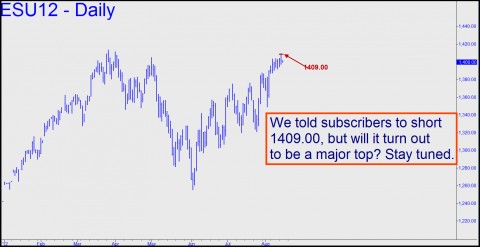With the E-Mini S&Ps and Apple shares stealing up on potentially important Hidden Pivot targets the other day, we shorted both on the off chance that we might be catching the Mother of All Bear Rally Tops. Of course, we’re not so crazy that we actually believe we’re going to nail the exact top of a bear rally that is now well into its fourth year. Still, it’s great fun to try, especially if you’re a permabear who believes, as we do, that one of these days stocks are going to take a plunge so nasty that it will make the 1987 Crash look like a picnic. Regardless of whether we’re right or dead wrong, however, we expect to make money on these trades. The trick is to catch a “a top,” if not “The Top,” and to take a small partial profit right away if possible. This helps build a risk cushion if our short whips around and heads higher, as happens so often. But it also allows us to book at least a small gain if we should eventually be forced to bail out just above where we got in. Rather than make bold claims about how often we succeed at this, we’d suggest asking subscribers yourself. Click here for a free trial subscription that will give you a week’s access to the Rick’s Picks chat room, which attracts experienced traders and ‘Pivoteers’ from around the world 24/7.
So how did yesterday’s two trades against-the-trend work out? Not too badly, actually. Although the Apple short was stopped out for a small loss because of a Hidden Pivot miscalculation (more on that below), at the final bell subscribers who followed the futures recommendation were still short the E-Mini with a paper profit of more than $400 per contract. Earlier, we’d advised them to get short at a 1409.00 target derived from Hidden Pivot Analysis. The target had been a while in coming, since we’d flagged it in the newsletter more than a week ago. But we were ready to pounce yesterday when it was finally hit, offering contracts short at 1409.00 with a stop-loss at 1410.25. The micro-tight, 1.25-point stop-loss carried a theoretical risk of $62.50, which is as much as we ever advise for trades, even long-termers, in this vehicle. As it happened, a stop-loss as tight as three ticks (i.e., 0.75 points, or $37.50 of theoretical risk per contract) would have held, since the futures went no higher on Monday than 1409.50. After apexing there, the September E-Mini S&P fell to a subsequent low of 1397.25, representing a theoretical gain thus far of $575 per contract. In practice, the paper gain could be even higher for some subscribers, since we advised them via an intraday bulletin to cover half of the initial short position when the futures were trading around 1404.00. For us, conservative, risk-averse play is standard operating procedure on both long and short trades – but especially on shorts, since odds will always be against hitting a major top on a given day.
Calendar Spreading ‘Directional’ Plays
Concerning the short in Apple, based on a Hidden Pivot rally target at 637.71, we told subscribers in an intraday bulletin to initiate the trade at 637.59, stop 638.05. (Alternatively, they could have bought far-out-of-the-money put spreads at the 620 strike – one of our favorite tactics for significantly reducing the risk of “directional” plays). A 46-cent stop-loss may sound too tight for a stock that has swung as much as $40 in a day, but it was actually somewhat wider than we usually advise, since it had been a while since we last suggested a trade in Apple. In the actual event, the stock topped at exactly 638.61 — 90 cents above our initial target — after rallying nearly $9 from the previous day’s close. On recalculating the target, however, we discovered an error that when corrected shifted it to 639.29, or 68 cents above the actual top. Oh well. Fortunately, there will always be another chance to short The Mother of All Tops – or, for that matter, to get long enroute to it if we can control the entry risk tightly enough.
***
Trading stocks, options and commodities in these treacherous times calls for great patience and skill. Click here if you’d like to see how Rick’s Picks approaches the challenge.


“Wall street wants Romney…”
Not so. No matter which major party candidate wins, Wall Street wins the election.